Massive sulfide Zn deposits in the Proterozoic did not require euxinia
Affiliations | Corresponding Author | Cite as | Funding information- Share this article





Article views:1,604Cumulative count of HTML views and PDF downloads.
- Download Citation
- Rights & Permissions
top
Abstract
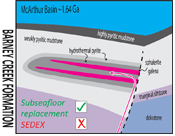
Figures and Tables
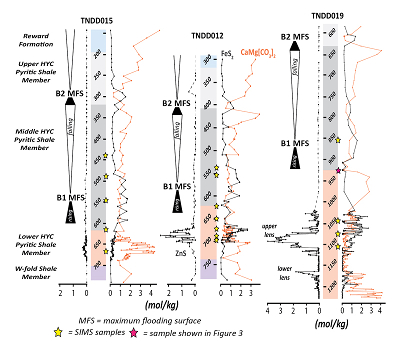 Figure 1 Chemostratigraphic sections of the Barney Creek Formation from 3 drill holes of the Teena sub-basin. Sequence stratigraphic relationships correspond with the regional framework in Kunzmann et al., (2019). See Supplementary Information for further details. | 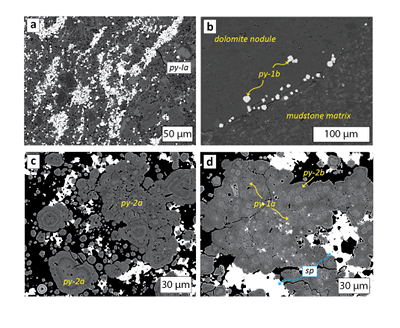 Figure 2 (a) Aggregates of py-1a within organic rich mudstone matrix. (b) Euhedral py-1b crystals within and around carbonate nodule. (c) Zoned aggregates of py-2a. (d) Aggregate of py-1a overgrown by py-2b. | 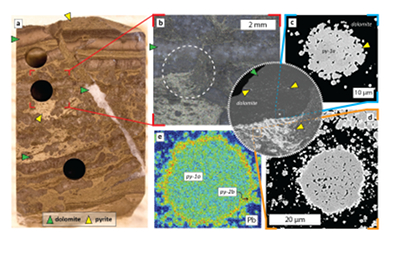 Figure 3 (a) Thin section block of sample selected for SIMS analysis (mineralised interval @ 925 m in 019; see Fig. 1). (b) Binocular photomicrograph of area selected for micro-drilling and inset showing a backscatter electron (BSE) image of the sample. Notice py-1a contained within dolomite nodule, indicating a pre-nodule origin. (c,d) BSE images of pyrite from the inset in (b). (e) Electron dispersive X-ray (EDX) false colour image, showing Pb enrichment (warm colours) in the fuzzy py-2b overgrowth. | 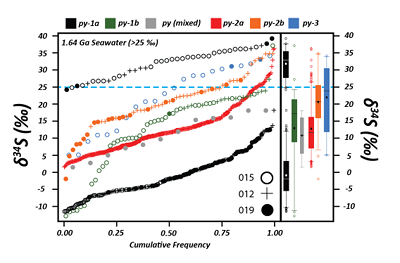 Figure 4 A cumulative frequency diagram of d34S values of all stages of the pyrite paragenesis. The sub-group of highly positive d34Spy-1a values is from samples from the high abundance interval. Mixed analyses where the analysis was of adjoining py-1 and 2 grains = py (mixed). The blue dashed line represents a minimum value for 1.64 Ga seawater sulfate (Li et al., 2015). |
| Figure 1 | Figure 2 | Figure 3 | Figure 4 |
top
Introduction
The Proterozoic Carpentaria Zn Province contains the largest accumulation of sediment-hosted base metals in the earth’s crust (nearly 120 Mt Zn and Pb; Huston et al., 2006
Huston, D.L., Stevens, B., Southgate, P.N., Muhling, P., Wyborn, L. (2006) Australian Zn-Pb-Ag Ore-Forming Systems: A Review and Analysis. Economic Geology 101, 1117–1157.
). Deposits of the northern Carpentaria Province are of particularly broad interest, as they are hosted within one of the few low metamorphic grade marine sedimentary basins from the Proterozoic. Since the early 20th century, world class (upper 10th centile contained metal) clastic-dominated (CD-type) deposit discoveries in the Carpentaria Province have averaged one per 20 years (McGoldrick et al., 2010McGoldrick, P., Winefield, P., Bull, S., Selley, D., Scott, R. (2010) Sequences, Synsedimentary Structures, and Sub-Basins: the Where and When of SEDEX Zinc Systems in the Southern McArthur Basin, Australia. Economic Geology Special Publication, 367–389.
). Yet with increased urbanisation and decarbonisation the global demand for Zn will continue, and some models predict a peak in Zn production within 20 years (Mohr et al., 2018Mohr, S., Giurco, D., Retamal, M., Mason, L., Mudd, G. (2018) Global Projection of Lead-Zinc Supply from Known Resources. Resources 7, 1–15.
).As the largest Zn reserves and resources occur in CD-type deposits, it is necessary to critically evaluate and improve existing genetic models to enhance the predictive capacity of exploration programmes. A restricted number of sedimentary basins in 2 broad time intervals (mid-Proterozoic and Palaeozoic) are known to host the largest CD-type deposits (Leach et al., 2010
Leach, D.L., Bradley, D.C., Huston, D., Pisarevsky, S.A., Taylor, R.D., Gardoll, J. (2010) Sediment-Hosted Lead-Zinc Deposits in Earth History. Economic Geology 105, 593–625.
). The most widely applied genetic model involves sedimentary exhalative (SEDEX) processes, where a sulfidic (euxinic) water column provides the in situ trap for hydrothermally vented metal-bearing fluids; the stratiform textures that are characteristic of CD-type deposits are then thought to result from the direct precipitation of sulfide minerals (pyrite, sphalerite, galena) from euxinic seawater (e.g., Large et al., 1998Large, R.R., Bull, S.W., Cooke, D.R., Mcgoldrick, P.J. (1998) A genetic model for the HYC deposit, Australia: Based on regional sedimentology, geochemistry, and sulfide-sediment relationships. Economic Geology 93, 1345–1368.
). Although models of Proterozoic ocean chemistry have been refined over recent decades – from the Canfield Ocean of widespread euxinia (Canfield, 1998Canfield, D.E. (1998) A new model for Proterozoic ocean chemistry. Nature 396, 450–453.
) to more recent models in which euxinia is more spatially and temporally restricted (Poulton and Canfeld, 2011Poulton, S.W., Canfeld, D.E. (2011) Ferruginous conditions: A dominant feature of the ocean through Earth’s history. Elements 7, 107–112.
) – the SEDEX paradigm persists and mineralisation is frequently taken as a priori evidence that euxinic conditions were prevalent (e.g., Johnston et al., 2008Johnston, D.T., Farquhar, J., Summons, R.E., Shen, Y., Kaufman, A.J., Masterson, A.L., Canfield, D.E. (2008) Sulfur isotope biogeochemistry of the Proterozoic McArthur Basin. Geochimica et Cosmochimica Acta 72, 4278–4290.
).In many cases, observations on the distribution and isotopic composition of pyrite provide the foundations for hydrothermal and palaeoenvironmental models (e.g. Lyons et al., 2000
Lyons, T.W., Luepke, J.J., Schreiber, M.E., Zieg, G.A. (2000) Sulfur geochemical constraints on Mesoproterozoic restricted marine deposition: Lower Belt Supergroup, northwestern United States. Geochimica et Cosmochimica Acta 64, 427–437.
; Ireland et al., 2004Ireland, T., Large, R.R., McGoldrick, P., Blake, M. (2004) Spatial distribution patterns of sulfur isotopes, nodular carbonate, and ore textures in the McArthur River (HYC) Zn-Pb-Ag deposit, Northern Territory, Australia. Economic Geology 99, 1687–1709.
). In this study, we focus on the most recent discovery in the Carpentaria Province – the Teena Zn-Pb deposit (Fig. S-1). Petrographic and geochemical data, collected through more than 600 m of stratigraphy, are presented for both mineralised and correlative un-mineralised samples. We demonstrate a high degree of variability in the overall abundance and isotopic composition (d34S value) of non-hydrothermal pyrite and show that euxinic conditions developed in response to high productivity during periods of high relative sea level. Contrary to the SEDEX model, hydrothermal pyrite has a much more restricted distribution and formed via sub-seafloor replacement processes. For exploration programmes, this means that the detectable footprint of CD-type deposits is more limited than predicted by the conventional SEDEX model.top
Samples and Methods
The Teena deposit is hosted within the 1.64 Ga Barney Creek Formation (BCF) and is located approximately 8 km from the super giant McArthur River Zn-Pb deposit in correlative stratigraphy. Samples were taken from 3 drill cores that intersect the two main mineralisation lenses and the hanging wall sequence of the Teena deposit (Figs. 1 and S-2). Each sample was examined under binocular microscope, and representative sub-samples were prepared as polished thin sections for petrographic analysis. Sub-samples for isotopic microanalysis were extracted from thin section blocks using a 4 mm diameter micro-drill, and then cast into an epoxy mount for imaging and SIMS analysis. See Supplementary Information for further details.
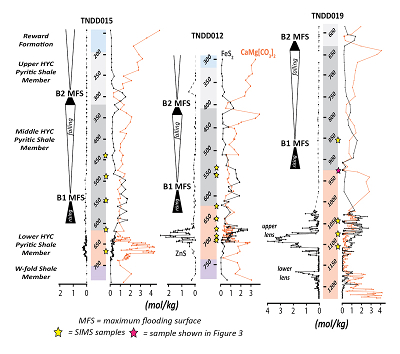
Figure 1 Chemostratigraphic sections of the Barney Creek Formation from 3 drill holes of the Teena sub-basin. Sequence stratigraphic relationships correspond with the regional framework in Kunzmann et al., (2019)
Kunzmann, M., Schmid, S., Blaikie, T.N., Halverson, G.P. (2019) Facies analysis, sequence stratigraphy, and carbon isotope chemostratigraphy of a classic Zn-Pb host succession: The Proterozoic middle McArthur Group, McArthur Basin, Australia. Ore Geology Reviews 106, 150-175.
. See Supplementary Information for further details.top
Results
Spatial and temporal pyrite distribution. There are two main generations of pyrite, each with two sub-types: (1a) micro-crystalline (<5 µm) and occasionally framboidal pyrite, which defines discontinuous laminations (Figs. 2a and S-3a), and (1b) slightly larger (>5 µm), idiomorphic euhedral pyrite, typically formed on the margins of nodular carbonate (Fig. 2b); (2a) spherical, concentrically zoned crystals with abundant host rock inclusions (Fig. 2c), and (2b) more irregular, anhedral overgrowths, which contain interstitial sphalerite and galena mineralisation (Fig. 2d). Both sub-types of py-2 preserve As and Pb enrichments (Fig. S-4). Volumetrically minor generations of coarse grained euhedral pyrite are associated with late stage sulfide-carbonate-quartz veins (py-3).
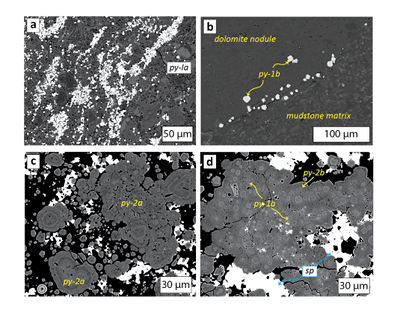
Figure 2 (a) Aggregates of py-1a within organic rich mudstone matrix. (b) Euhedral py-1b crystals within and around carbonate nodule. (c) Zoned aggregates of py-2a. (d) Aggregate of py-1a overgrown by py-2b.
Pyrite-1a pre-dates dolomite nodule formation (Fig. 3b inset), whereas py-1b occurs on the margins of dolomite nodules (Fig. 2b), consistent with formation during later stages of nodule growth. The pyrite associated with the sphalerite and galena is more massive, and forms anhedral overgrowths of earlier py-1 (Fig. 2d). Sphalerite does not occur within nodular dolomite, but commonly replaces nodule margins, attesting to a strictly post-nodule timing for mineralisation.
The only pyrite present throughout the stratigraphic interval is py-1a, which is highly abundant within correlative carbonaceous intervals in all 3 drill holes (Figs. 1 and S-5). All other types of pyrite are restricted either to samples containing nodular carbonate (py-1b; Fig. 2b), or to within the mineralised interval (py-2; Fig. 2c,d). In terms of a lateral pyrite halo, the overall abundance of pyrite clearly decreases within the mineralised interval (across 1.5 km from 019 > 012 > 015; Figs. 1 and S-5).
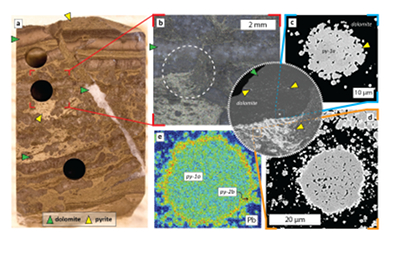
Figure 3 (a) Thin section block of sample selected for SIMS analysis (mineralised interval @ 925 m in 019; see Fig. 1). (b) Binocular photomicrograph of area selected for micro-drilling and inset showing a backscatter electron (BSE) image of the sample. Notice py-1a contained within dolomite nodule, indicating a pre-nodule origin. (c,d) BSE images of pyrite from the inset in (b). (e) Electron dispersive X-ray (EDX) false colour image, showing Pb enrichment (warm colours) in the fuzzy py-2b overgrowth.
d34Spyrite values. The d34S values for pyrite are shown in Figure 4. There is a strong stratigraphic control on the isotopic composition of py-1a, and highly positive d34S values are preserved in all 3 drill holes within the high pyrite abundance interval (Figs. 1 and 4). Within the mineralised intervals there is a high degree of isotopic heterogeneity within individual crystals, i.e. on the micro-scale. The zoned aggregates of py-2 preserve d34S values that are intermediate between the end members of py-1a, but there are no systematic trends within individual samples.
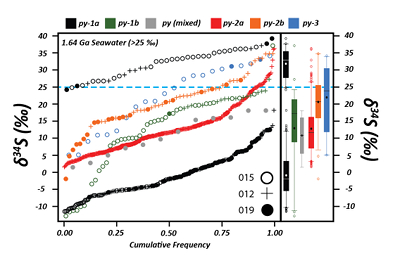
Figure 4 A cumulative frequency diagram of d34S values of all stages of the pyrite paragenesis. The sub-group of highly positive d34Spy-1a values is from samples from the high abundance interval. Mixed analyses where the analysis was of adjoining py-1 and 2 grains = py (mixed). The blue dashed line represents a minimum value for 1.64 Ga seawater sulfate (Li et al., 2015
Li, C., Planavsky, N.J., Love, G.D., Reinhard, C.T., Hardisty, D., Feng, L., Bates, S.M., Huang, J., Zhang, Q., Chu, X., Lyons, T.W. (2015) Marine redox conditions in the middle Proterozoic ocean and isotopic constraints on authigenic carbonate formation: Insights from the Chuanlinggou Formation, Yanshan Basin, North China. Geochimica et Cosmochimica Acta 150, 90–105.
).top
Discussion
Timing and distribution of mineralisation in the Teena sub-basin. The Teena deposit shares many features (e.g., stratiform sulfide textures; Fig. S-3) with the McArthur River (HYC) deposit, which is used as the type example of SEDEX mineralisation in the Carpentaria Province (Large et al., 1998
Large, R.R., Bull, S.W., Cooke, D.R., Mcgoldrick, P.J. (1998) A genetic model for the HYC deposit, Australia: Based on regional sedimentology, geochemistry, and sulfide-sediment relationships. Economic Geology 93, 1345–1368.
). In the SEDEX model, coeval formation of py-1 and sphalerite occurs within an anoxic brine pool (e.g., Ireland et al., 2004Ireland, T., Large, R.R., McGoldrick, P., Blake, M. (2004) Spatial distribution patterns of sulfur isotopes, nodular carbonate, and ore textures in the McArthur River (HYC) Zn-Pb-Ag deposit, Northern Territory, Australia. Economic Geology 99, 1687–1709.
) and py-2 post-dates hydrothermal mineralisation (e.g., Large et al., 1998Large, R.R., Bull, S.W., Cooke, D.R., Mcgoldrick, P.J. (1998) A genetic model for the HYC deposit, Australia: Based on regional sedimentology, geochemistry, and sulfide-sediment relationships. Economic Geology 93, 1345–1368.
). These relationships are not observed in the Teena deposit as micro-scale observations show that sphalerite clearly post-dates formation of early diagenetic py-1 (e.g., Fig. 2) and is interstitial to py-2 (which is also hydrothermally enriched in As and Pb; Fig. S-4).A minimum depth constraint for the timing of mineralisation in the subsurface can be inferred from the paragenetic relationship between py-2 and nodular dolomite within the hanging wall sequence. At the top of the Lower HYC Member (925 m, TNDD019; pink star in Fig. 1), the py-1a that is overgrown by nodular dolomite has been protected from hydrothermal overgrowth (py-2b), unlike the pyrite that formed within the mudstone matrix (Fig. 3). The weak mineralisation at this higher stratigraphic level postdates the formation of nodular dolomite and represents the uppermost expression of the high grade mineralisation 200 m lower in the stratigraphy.
There is also a marked decrease in the lateral distribution of pyrite within the mineralised interval, which in TNDD015 is at levels overlapping with the un-mineralised Middle to Upper HYC Members (<0.5 mol/kg FeS2; Fig. 1). As a result, the lateral extent of hydrothermal pyrite in the Teena sub-basin (<1.5 km; Fig. S-5) is far more restricted than the 10s of km suggested by the SEDEX model (e.g., Mukherjee and Large, 2017
Mukherjee, I., Large, R. (2017) Application of pyrite trace element chemistry to exploration for SEDEX style Zn-Pb deposits: McArthur Basin, Northern Territory, Australia. Ore Geology Reviews 81, 1249–1270.
).Stratigraphic variability of d34Spyrite values in the Teena sub-basin. The interpretation of d34Spyrite values forms a common framework for both the SEDEX model and studies that focus on broader aspects of Proterozoic seawater chemistry. In either case, the development of highly positive d34S values has been linked to water mass restriction, during which microbial sulfate reduction (MSR) produced basin scale closed system Rayleigh fractionation effects (e.g., Lyons et al., 2000
Lyons, T.W., Luepke, J.J., Schreiber, M.E., Zieg, G.A. (2000) Sulfur geochemical constraints on Mesoproterozoic restricted marine deposition: Lower Belt Supergroup, northwestern United States. Geochimica et Cosmochimica Acta 64, 427–437.
, 2006Lyons, T.W., Gellatly, A.M., McGoldrick, P.J., Kah, L.C. (2006) Proterozoic sedimentary exhalative (SEDEX) deposits and links to evolving global ocean chemistry. Geological Society of America Memoirs 198, 169–184.
).There is general agreement that the d34S value of 1.64 Ga seawater sulfate was >25 ‰ (Li et al., 2015
Li, C., Planavsky, N.J., Love, G.D., Reinhard, C.T., Hardisty, D., Feng, L., Bates, S.M., Huang, J., Zhang, Q., Chu, X., Lyons, T.W. (2015) Marine redox conditions in the middle Proterozoic ocean and isotopic constraints on authigenic carbonate formation: Insights from the Chuanlinggou Formation, Yanshan Basin, North China. Geochimica et Cosmochimica Acta 150, 90–105.
). Following on, the lowest d34Spy-1 values in the Teena sub-basin represent a large offset from seawater sulfate (?34S = 35 ‰), typical of sulfide generated during MSR in relatively open system conditions. Pyrite associated with nodular carbonate (py-1b) is characterised by d34S values that are higher than the majority of py-1a (Fig. 4; high pyrite abundance interval excluded). The development of more positive d34S values is characteristic of sulfide generated within pore fluids during later diagenesis, either via MSR or sulfate reduction coupled with anaerobic oxidation of methane at the sulfate methane transition zone (e.g., Borowski et al., 2013Borowski, W.S., Rodriguez, N.M., Paull, C.K., Ussler, W. (2013) Are 34S-enriched authigenic sulfide minerals a proxy for elevated methane flux and gas hydrates in the geologic record? Marine and Petroleum Geology 43, 381–395.
; Lin et al., 2016Lin, Z., Sun, X., Peckmann, J., Lu, Y., Xu, L., Strauss, H., Zhou, H., Gong, J., Lu, H., Teichert, B.M.A. (2016) How sulfate-driven anaerobic oxidation of methane affects the sulfur isotopic composition of pyrite: A SIMS study from the South China Sea. Chemical Geology 440, 26–41.
; Magnall et al., 2016Magnall, J.M., Gleeson, S.A., Stern, R.A., Newton, R.J., Poulton, S.W., Paradis, S. (2016) Open system sulphate reduction in a diagenetic environment - isotopic analysis of barite (d34S and d18O) and pyrite (d34S) from the Tom and Jason Late Devonian Zn-Pb-Ba deposits, Selwyn Basin, Canada. Geochimica et Cosmochimica Acta 180, 146–163.
). In either case, the development of more positive d34S values is restricted to pore fluids and cannot be linked to water mass restriction. In contrast, the interval of high pyrite abundance preserves particularly positive d34Spy-1a values, which are clearly different from all other sub-types of pyrite (Fig. 4). Moreover, correlation of this interval between the 3 drill holes indicates it is not a localised effect, but a larger scale feature of the sulfur cycle in the Teena sub-basin. The development of positive d34S values on a basin scale typically occurs during pyrite formation under sulfate limited, euxinic conditions (Gomes and Hurtgen, 2015Gomes, M.L., Hurtgen, M.T. (2015) Sulfur isotope fractionation in modern euxinic systems: Implications for paleoenvironmental reconstructions of paired sulfate-sulfide isotope records. Geochimica et Cosmochimica Acta 157, 39–55.
).Water mass restriction is commonly cited as a driving mechanism for sulfate limitation in Proterozoic basins (e.g., Lyons et al., 2000
Lyons, T.W., Luepke, J.J., Schreiber, M.E., Zieg, G.A. (2000) Sulfur geochemical constraints on Mesoproterozoic restricted marine deposition: Lower Belt Supergroup, northwestern United States. Geochimica et Cosmochimica Acta 64, 427–437.
). Nevertheless, the high pyrite abundance intervals within the BCF correspond with a marine transgression and a period of high relative sea level (Fig. 1; Kunzmann et al., 2019Kunzmann, M., Schmid, S., Blaikie, T.N., Halverson, G.P. (2019) Facies analysis, sequence stratigraphy, and carbon isotope chemostratigraphy of a classic Zn-Pb host succession: The Proterozoic middle McArthur Group, McArthur Basin, Australia. Ore Geology Reviews 106, 150-175.
), meaning basin restriction is unlikely to have been the primary control on sulfate limitation. Instead, we propose that sulfate limited conditions developed in a euxinic water column when a high organic carbon flux promoted MSR (Johnston et al., 2010Johnston, D.T., Poulton, S.W., Dehler, C., Porter, S., Husson, J., Canfield, D.E., Knoll, A.H. (2010) An emerging picture of Neoproterozoic ocean chemistry: Insights from the Chuar Group, Grand Canyon, USA. Earth and Planetary Science Letters 290, 64–73.
). For individual sub-basins within the McArthur Basin, rising sea level would have resulted in enhanced circulation and nutrient replenishment, following which sulfate limitation developed as a symptom of high productivity (and organic flux) rather than water mass restriction (e.g., Cox et al., 2016Cox, G.M., Jarrett, A., Edwards, D., Crockford, P.W., Halverson, G.P., Collins, A.S., Poirier, A., Li, Z.X. (2016) Basin redox and primary productivity within the Mesoproterozoic Roper Seaway. Chemical Geology 440, 101–114.
).The evidence of sulfate limitation also poses a mass balance problem for models in which mineralisation forms from reduced sulfur derived in situ and entirely from seawater sulfate. For example, the maximum sulfide abundance within the MFS intervals (<1.5 mol/kg), which represents an upper limit to the reduced sulfur available under steady state conditions, is much lower than in the mineralised interval (>4 mol/kg). To satisfy the hydrothermal mass balance, therefore, requires an additional source of reduced sulfur to the system, e.g., sulfur supplied by the hydrothermal fluid (Cooke et al., 2000
Cooke, D.R., Bull, S.W., Large, R.R., McGoldrick, P.J. (2000) The importance of oxidized brines for the formation of australian Proterozoic stratiform sediment-hosted Pb-Zn (sedex) deposits. Economic Geology 95, 1–18.
) or sour gas (Cai et al., 2003Cai, C., Worden, R.H., Bottrell, S.H., Wang, L., Yang, C. (2003) Thermochemical sulphate reduction and the generation of hydrogen sulphide and thiols (mercaptans) in Triassic carbonate reservoirs from the Sichuan Basin, China. Chemical Geology 202, 39–57.
).Implications. In the Teena sub-basin, the laterally extensive high abundance pyrite intervals within the hanging wall stratigraphy are unrelated to hydrothermal processes, meaning exploration strategies that focus on pyrite detection alone as an indication of prospectivity may be ineffective. Instead, pyrite formation was enhanced during periods of high biological activity that was stimulated by nutrient supply under conditions of high relative sea level. In Proterozoic basins, future researchers should avoid invoking basin wide euxinia on account of the preservation of CD-type deposits and instead focus efforts towards understanding feedbacks between sea level, nutrient supply and biological productivity (e.g., Cox et al., 2019
Cox, G.M., Sansjofre, P., Blades, M., Farkas, J., Collins, A.S. (2019) Dynamic interaction between basin redox and the biogeochemical nitrogen cycle in an unconventional Proterozoic petroleum system. Scientific Reports 9, 1–11.
).In terms of the mineral system, there is growing consensus that euxinic conditions are not a pre-requisite for the formation of CD-type deposits, either in the Proterozoic (this study) or Phanerozoic (e.g., Johnson et al., 2018
Johnson, C.A., Slack, J.F., Dumoulin, J.A., Kelley, K.D., Falck, H. (2018) Sulfur isotopes of host strata for Howards Pass (Yukon-Northwest Territories) Zn-Pb deposits implicate anaerobic oxidation of methane, not basin stagnation. Geology 46, 619–622.
; Magnall et al., 2018Magnall, J.M., Gleeson, S.A., Poulton, S.W., Gordon, G.W., Paradis, S. (2018) Links between seawater paleoredox and the formation of sediment-hosted massive sulphide (SHMS) deposits – Fe speciation and Mo isotope constraints from Late Devonian mudstones. Chemical Geology 490, 45–60.
). As a result, mineralisation may not necessarily occur within the most reducing lithologies and the in situ metal trap that is invoked by the SEDEX model should be reconsidered. Similar to hydrocarbon studies, new genetic models should be derived from more basin scale approaches that can describe subsurface hydrothermal mass transfer and metal trap dynamics. Ultimately, this will lead to a greater understanding of what restricts the distribution of CD-type deposits to a few specific basins in the geologic record and facilitate a more predictive approach to exploration.top
Conclusions
The distribution of fine grained pyrite around the mid-Proterozoic Teena CD-type deposit has no relationship with hydrothermal mineralisation. Moreover, intervals of high pyrite abundance and highly positive d34Spyrite values correspond with periods of high relative sea level and have no relationship with basin restriction. Mineralisation formed later and during burial diagenesis. Altogether, this means that:
- Evidence of sulfate limitation in Proterozoic basins is not necessarily indicative of basin restriction.
- Mineralisation at the Teena deposit formed during burial diagenesis, meaning CD-type deposits should not be used a priori as evidence of a sulfidic (euxinic) water column.
- Formation of the sulfide mineralisation at Teena requires an additional source of reduced sulfur, either from basinal (e.g., sour gas) or hydrothermal fluids.
top
Acknowledgements
We acknowledge funding from the Helmholtz-Rekrutierungsinitive, thank Frederic Couffignal (GFZ) for assistance with SIMS analyses, Franzi Wilke (GFZ) for help with EPMA mapping, and Richard Stern for supplying the S0302A pyrite standard. The logistical support and permission to publish from Teck is gratefully acknowledged. Finally, we would like to thank 2 reviewers (Sam Spinks and anonymous) for their constructive comments.
Editor: Ariel Anbar
top
References
Borowski, W.S., Rodriguez, N.M., Paull, C.K., Ussler, W. (2013) Are 34S-enriched authigenic sulfide minerals a proxy for elevated methane flux and gas hydrates in the geologic record? Marine and Petroleum Geology 43, 381–395.
 Show in context
Show in context The development of more positive d34S values is characteristic of sulfide generated within pore fluids during later diagenesis, either via MSR or sulfate reduction coupled with anaerobic oxidation of methane at the sulfate methane transition zone (e.g., Borowski et al., 2013; Lin et al., 2016; Magnall et al., 2016).
View in article
Cai, C., Worden, R.H., Bottrell, S.H., Wang, L., Yang, C. (2003) Thermochemical sulphate reduction and the generation of hydrogen sulphide and thiols (mercaptans) in Triassic carbonate reservoirs from the Sichuan Basin, China. Chemical Geology 202, 39–57.
 Show in context
Show in context To satisfy the hydrothermal mass balance, therefore, requires an additional source of reduced sulfur to the system, e.g., sulfur supplied by the hydrothermal fluid (Cooke et al., 2000) or sour gas (Cai et al., 2003).
View in article
Canfield, D.E. (1998) A new model for Proterozoic ocean chemistry. Nature 396, 450–453.
 Show in context
Show in context Although models of Proterozoic ocean chemistry have been refined over recent decades – from the Canfield Ocean of widespread euxinia (Canfield, 1998) to more recent models in which euxinia is more spatially and temporally restricted (Poulton and Canfeld, 2011) – the SEDEX paradigm persists and mineralisation is frequently taken as a priori evidence that euxinic conditions were prevalent (e.g., Johnston et al., 2008).
View in article
Cooke, D.R., Bull, S.W., Large, R.R., McGoldrick, P.J. (2000) The importance of oxidized brines for the formation of australian Proterozoic stratiform sediment-hosted Pb-Zn (sedex) deposits. Economic Geology 95, 1–18.
 Show in context
Show in contextTo satisfy the hydrothermal mass balance, therefore, requires an additional source of reduced sulfur to the system, e.g., sulfur supplied by the hydrothermal fluid (Cooke et al., 2000) or sour gas (Cai et al., 2003).
View in article
Cox, G.M., Jarrett, A., Edwards, D., Crockford, P.W., Halverson, G.P., Collins, A.S., Poirier, A., Li, Z.X. (2016) Basin redox and primary productivity within the Mesoproterozoic Roper Seaway. Chemical Geology 440, 101–114.
 Show in context
Show in context For individual sub-basins within the McArthur Basin, rising sea level would have resulted in enhanced circulation and nutrient replenishment, following which sulfate limitation developed as a symptom of high productivity (and organic flux) rather than water mass restriction (e.g., Cox et al., 2016).
View in article
Cox, G.M., Sansjofre, P., Blades, M., Farkas, J., Collins, A.S. (2019) Dynamic interaction between basin redox and the biogeochemical nitrogen cycle in an unconventional Proterozoic petroleum system. Scientific Reports 9, 1–11.
 Show in context
Show in contextIn Proterozoic basins, future researchers should avoid invoking basin wide euxinia on account of the preservation of CD-type deposits and instead focus efforts towards understanding feedbacks between sea level, nutrient supply and biological productivity (e.g., Cox et al., 2019).
View in article
Gomes, M.L., Hurtgen, M.T. (2015) Sulfur isotope fractionation in modern euxinic systems: Implications for paleoenvironmental reconstructions of paired sulfate-sulfide isotope records. Geochimica et Cosmochimica Acta 157, 39–55.
 Show in context
Show in contextThe development of positive d34S values on a basin scale typically occurs during pyrite formation under sulfate limited, euxinic conditions (Gomes and Hurtgen, 2015).
View in article
Huston, D.L., Stevens, B., Southgate, P.N., Muhling, P., Wyborn, L. (2006) Australian Zn-Pb-Ag Ore-Forming Systems: A Review and Analysis. Economic Geology 101, 1117–1157.
 Show in context
Show in context The Proterozoic Carpentaria Zn Province contains the largest accumulation of sediment-hosted base metals in the earth’s crust (nearly 120 Mt Zn and Pb; Huston et al., 2006).
View in article
Ireland, T., Large, R.R., McGoldrick, P., Blake, M. (2004) Spatial distribution patterns of sulfur isotopes, nodular carbonate, and ore textures in the McArthur River (HYC) Zn-Pb-Ag deposit, Northern Territory, Australia. Economic Geology 99, 1687–1709.
 Show in context
Show in context In many cases, observations on the distribution and isotopic composition of pyrite provide the foundations for hydrothermal and palaeoenvironmental models (e.g. Lyons et al., 2000; Ireland et al., 2004).
View in article
In the SEDEX model, coeval formation of py-1 and sphalerite occurs within an anoxic brine pool (e.g., Ireland et al., 2004) and py-2 post-dates hydrothermal mineralisation (e.g., Large et al., 1998).
View in article
Johnson, C.A., Slack, J.F., Dumoulin, J.A., Kelley, K.D., Falck, H. (2018) Sulfur isotopes of host strata for Howards Pass (Yukon-Northwest Territories) Zn-Pb deposits implicate anaerobic oxidation of methane, not basin stagnation. Geology 46, 619–622.
 Show in context
Show in context In terms of the mineral system, there is growing consensus that euxinic conditions are not a pre-requisite for the formation of CD-type deposits, either in the Proterozoic (this study) or Phanerozoic (e.g., Johnson et al., 2018; Magnall et al., 2018).
View in article
Johnston, D.T., Farquhar, J., Summons, R.E., Shen, Y., Kaufman, A.J., Masterson, A.L., Canfield, D.E. (2008) Sulfur isotope biogeochemistry of the Proterozoic McArthur Basin. Geochimica et Cosmochimica Acta 72, 4278–4290.
 Show in context
Show in contextAlthough models of Proterozoic ocean chemistry have been refined over recent decades – from the Canfield Ocean of widespread euxinia (Canfield, 1998) to more recent models in which euxinia is more spatially and temporally restricted (Poulton and Canfeld, 2011) – the SEDEX paradigm persists and mineralisation is frequently taken as a priori evidence that euxinic conditions were prevalent (e.g., Johnston et al., 2008).
View in article
Johnston, D.T., Poulton, S.W., Dehler, C., Porter, S., Husson, J., Canfield, D.E., Knoll, A.H. (2010) An emerging picture of Neoproterozoic ocean chemistry: Insights from the Chuar Group, Grand Canyon, USA. Earth and Planetary Science Letters 290, 64–73.
 Show in context
Show in contextInstead, we propose that sulfate limited conditions developed in a euxinic water column when a high organic carbon flux promoted MSR (Johnston et al., 2010).
View in article
Kunzmann, M., Schmid, S., Blaikie, T.N., Halverson, G.P. (2019) Facies analysis, sequence stratigraphy, and carbon isotope chemostratigraphy of a classic Zn-Pb host succession: The Proterozoic middle McArthur Group, McArthur Basin, Australia. Ore Geology Reviews 106, 150-175.
 Show in context
Show in context Figure 1 [...] Sequence stratigraphic relationships correspond with the regional framework in Kunzmann et al., (2019).
View in article
Nevertheless, the high pyrite abundance intervals within the BCF correspond with a marine transgression and a period of high relative sea level (Fig. 1; Kunzmann et al., 2019), meaning basin restriction is unlikely to have been the primary control on sulfate limitation.
View in article
Large, R.R., Bull, S.W., Cooke, D.R., Mcgoldrick, P.J. (1998) A genetic model for the HYC deposit, Australia: Based on regional sedimentology, geochemistry, and sulfide-sediment relationships. Economic Geology 93, 1345–1368.
 Show in context
Show in context The most widely applied genetic model involves sedimentary exhalative (SEDEX) processes, where a sulfidic (euxinic) water column provides the in situ trap for hydrothermally vented metal-bearing fluids; the stratiform textures that are characteristic of CD-type deposits are then thought to result from the direct precipitation of sulfide minerals (pyrite, sphalerite, galena) from euxinic seawater (e.g., Large et al., 1998).
View in article
The Teena deposit shares many features (e.g., stratiform sulfide textures; Fig. S-3) with the McArthur River (HYC) deposit, which is used as the type example of SEDEX mineralisation in the Carpentaria Province (Large et al., 1998).
View in article
In the SEDEX model, coeval formation of py-1 and sphalerite occurs within an anoxic brine pool (e.g., Ireland et al., 2004) and py-2 post-dates hydrothermal mineralisation (e.g., Large et al., 1998).
View in article
Leach, D.L., Bradley, D.C., Huston, D., Pisarevsky, S.A., Taylor, R.D., Gardoll, J. (2010) Sediment-Hosted Lead-Zinc Deposits in Earth History. Economic Geology 105, 593–625.
 Show in context
Show in contextA restricted number of sedimentary basins in 2 broad time intervals (mid-Proterozoic and Palaeozoic) are known to host the largest CD-type deposits (Leach et al., 2010).
View in article
Li, C., Planavsky, N.J., Love, G.D., Reinhard, C.T., Hardisty, D., Feng, L., Bates, S.M., Huang, J., Zhang, Q., Chu, X., Lyons, T.W. (2015) Marine redox conditions in the middle Proterozoic ocean and isotopic constraints on authigenic carbonate formation: Insights from the Chuanlinggou Formation, Yanshan Basin, North China. Geochimica et Cosmochimica Acta 150, 90–105.
 Show in context
Show in contextFigure 4 [...] The blue dashed line represents a minimum value for 1.64 Ga seawater sulfate (Li et al., 2015).
View in article
There is general agreement that the d34S value of 1.64 Ga seawater sulfate was >25 ‰ (Li et al., 2015).
View in article
Lin, Z., Sun, X., Peckmann, J., Lu, Y., Xu, L., Strauss, H., Zhou, H., Gong, J., Lu, H., Teichert, B.M.A. (2016) How sulfate-driven anaerobic oxidation of methane affects the sulfur isotopic composition of pyrite: A SIMS study from the South China Sea. Chemical Geology 440, 26–41.
 Show in context
Show in context The development of more positive d34S values is characteristic of sulfide generated within pore fluids during later diagenesis, either via MSR or sulfate reduction coupled with anaerobic oxidation of methane at the sulfate methane transition zone (e.g., Borowski et al., 2013; Lin et al., 2016; Magnall et al., 2016).
View in article
Lyons, T.W., Luepke, J.J., Schreiber, M.E., Zieg, G.A. (2000) Sulfur geochemical constraints on Mesoproterozoic restricted marine deposition: Lower Belt Supergroup, northwestern United States. Geochimica et Cosmochimica Acta 64, 427–437.
 Show in context
Show in context In many cases, observations on the distribution and isotopic composition of pyrite provide the foundations for hydrothermal and palaeoenvironmental models (e.g. Lyons et al., 2000; Ireland et al., 2004).
View in article
In either case, the development of highly positive d34S values has been linked to water mass restriction, during which microbial sulfate reduction (MSR) produced basin scale closed system Rayleigh fractionation effects (e.g., Lyons et al., 2000, 2006).
View in article
Water mass restriction is commonly cited as a driving mechanism for sulfate limitation in Proterozoic basins (e.g., Lyons et al., 2000).
View in article
Lyons, T.W., Gellatly, A.M., McGoldrick, P.J., Kah, L.C. (2006) Proterozoic sedimentary exhalative (SEDEX) deposits and links to evolving global ocean chemistry. Geological Society of America Memoirs 198, 169–184.
 Show in context
Show in context In either case, the development of highly positive d34S values has been linked to water mass restriction, during which microbial sulfate reduction (MSR) produced basin scale closed system Rayleigh fractionation effects (e.g., Lyons et al., 2000, 2006).
View in article
Magnall, J.M., Gleeson, S.A., Stern, R.A., Newton, R.J., Poulton, S.W., Paradis, S. (2016) Open system sulphate reduction in a diagenetic environment - isotopic analysis of barite (d34S and d18O) and pyrite (d34S) from the Tom and Jason Late Devonian Zn-Pb-Ba deposits, Selwyn Basin, Canada. Geochimica et Cosmochimica Acta 180, 146–163.
 Show in context
Show in context The development of more positive d34S values is characteristic of sulfide generated within pore fluids during later diagenesis, either via MSR or sulfate reduction coupled with anaerobic oxidation of methane at the sulfate methane transition zone (e.g., Borowski et al., 2013; Lin et al., 2016; Magnall et al., 2016).
View in article
Magnall, J.M., Gleeson, S.A., Poulton, S.W., Gordon, G.W., Paradis, S. (2018) Links between seawater paleoredox and the formation of sediment-hosted massive sulphide (SHMS) deposits – Fe speciation and Mo isotope constraints from Late Devonian mudstones. Chemical Geology 490, 45–60.
 Show in context
Show in contextIn terms of the mineral system, there is growing consensus that euxinic conditions are not a pre-requisite for the formation of CD-type deposits, either in the Proterozoic (this study) or Phanerozoic (e.g., Johnson et al., 2018; Magnall et al., 2018).
View in article
McGoldrick, P., Winefield, P., Bull, S., Selley, D., Scott, R. (2010) Sequences, Synsedimentary Structures, and Sub-Basins: the Where and When of SEDEX Zinc Systems in the Southern McArthur Basin, Australia. Economic Geology Special Publication, 367–389.
 Show in context
Show in contextSince the early 20th century, world class (upper 10th centile contained metal) clastic-dominated (CD-type) deposit discoveries in the Carpentaria Province have averaged one per 20 years (McGoldrick et al., 2010).
View in article
Mohr, S., Giurco, D., Retamal, M., Mason, L., Mudd, G. (2018) Global Projection of Lead-Zinc Supply from Known Resources. Resources 7, 1–15.
 Show in context
Show in context Yet with increased urbanisation and decarbonisation the global demand for Zn will continue, and some models predict a peak in Zn production within 20 years (Mohr et al., 2018).
View in article
Mukherjee, I., Large, R. (2017) Application of pyrite trace element chemistry to exploration for SEDEX style Zn-Pb deposits: McArthur Basin, Northern Territory, Australia. Ore Geology Reviews 81, 1249–1270.
 Show in context
Show in contextAs a result, the lateral extent of hydrothermal pyrite in the Teena sub-basin (<1.5 km; Fig. S-5) is far more restricted than the 10s of km suggested by the SEDEX model (e.g., Mukherjee and Large, 2017).
View in article
Poulton, S.W., Canfeld, D.E. (2011) Ferruginous conditions: A dominant feature of the ocean through Earth’s history. Elements 7, 107–112.
 Show in context
Show in contextAlthough models of Proterozoic ocean chemistry have been refined over recent decades – from the Canfield Ocean of widespread euxinia (Canfield, 1998) to more recent models in which euxinia is more spatially and temporally restricted (Poulton and Canfeld, 2011) – the SEDEX paradigm persists and mineralisation is frequently taken as a priori evidence that euxinic conditions were prevalent (e.g., Johnston et al., 2008).
View in article
top
Supplementary Information
The Supplementary Information includes:
- Geological Setting
- Methodology
- Table S-1
- Figures S-1 to S-5
- Supplementary Information References
Download Table S-1 (Excel).
Download the Supplementary Information (PDF).
Figures and Tables
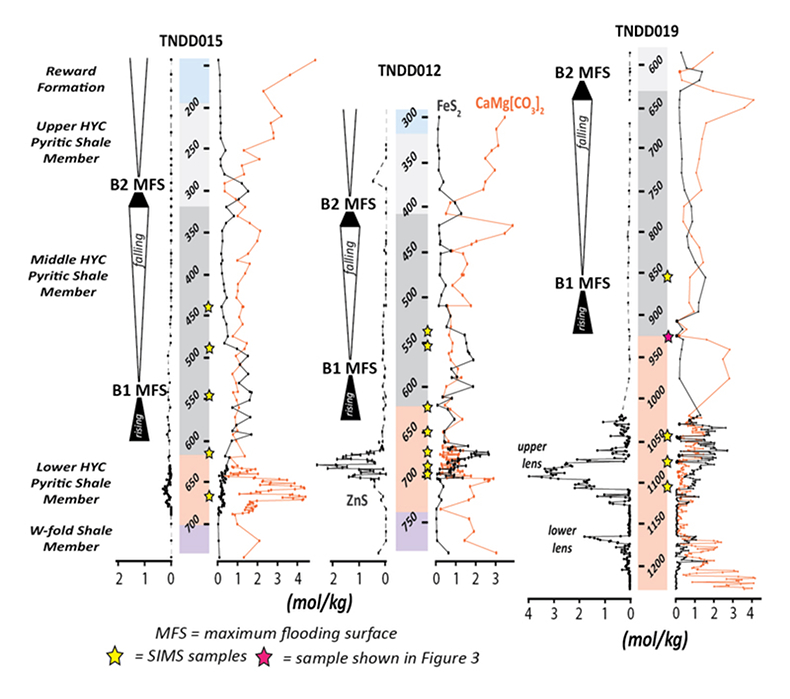
Figure 1 Chemostratigraphic sections of the Barney Creek Formation from 3 drill holes of the Teena sub-basin. Sequence stratigraphic relationships correspond with the regional framework in Kunzmann et al., (2019)
Kunzmann, M., Schmid, S., Blaikie, T.N., Halverson, G.P. (2019) Facies analysis, sequence stratigraphy, and carbon isotope chemostratigraphy of a classic Zn-Pb host succession: The Proterozoic middle McArthur Group, McArthur Basin, Australia. Ore Geology Reviews 106, 150-175.
. See Supplementary Information for further details.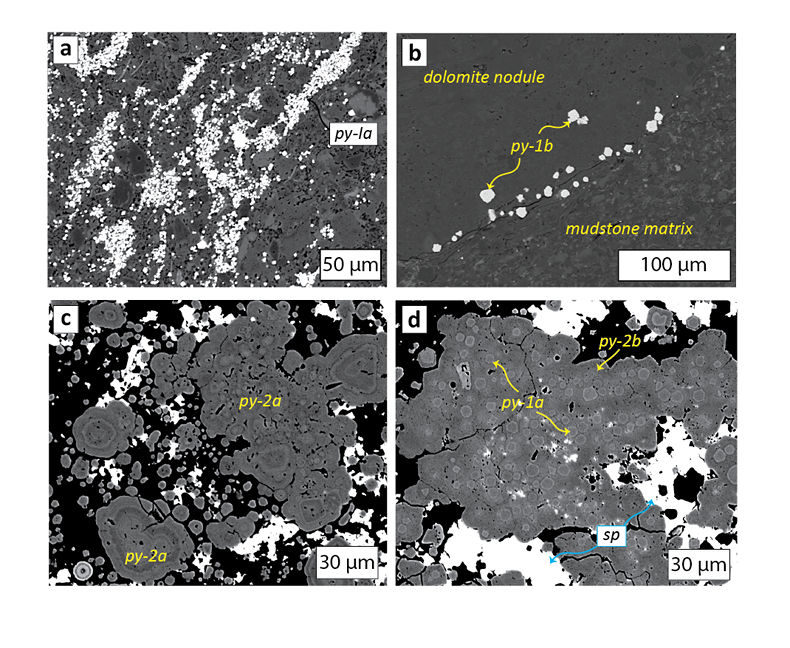
Figure 2 (a) Aggregates of py-1a within organic rich mudstone matrix. (b) Euhedral py-1b crystals within and around carbonate nodule. (c) Zoned aggregates of py-2a. (d) Aggregate of py-1a overgrown by py-2b.
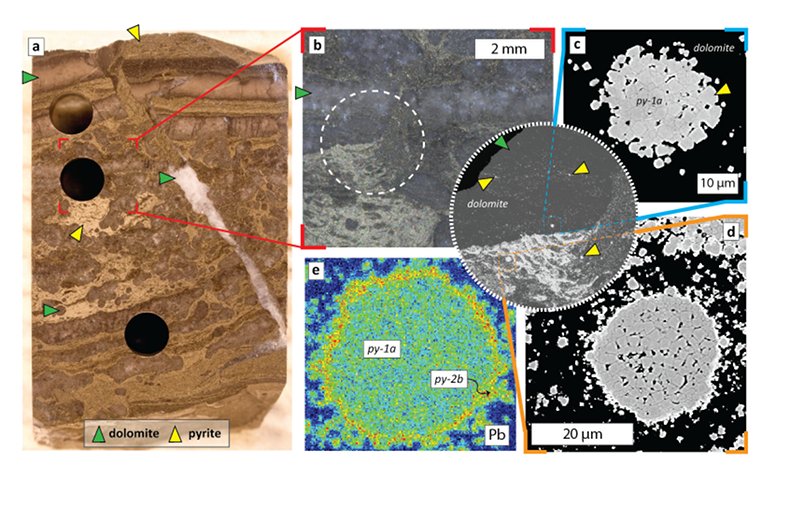
Figure 3 (a) Thin section block of sample selected for SIMS analysis (mineralised interval @ 925 m in 019; see Fig. 1). (b) Binocular photomicrograph of area selected for micro-drilling and inset showing a backscatter electron (BSE) image of the sample. Notice py-1a contained within dolomite nodule, indicating a pre-nodule origin. (c,d) BSE images of pyrite from the inset in (b). (e) Electron dispersive X-ray (EDX) false colour image, showing Pb enrichment (warm colours) in the fuzzy py-2b overgrowth.
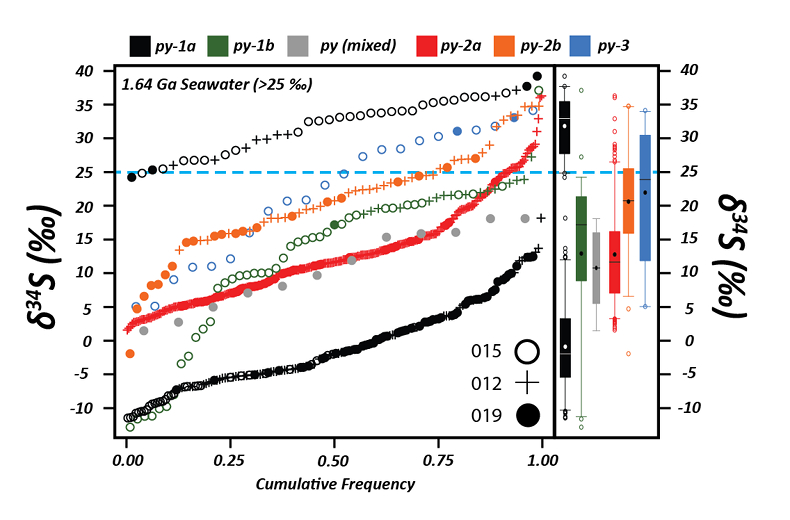
Figure 4 A cumulative frequency diagram of d34S values of all stages of the pyrite paragenesis. The sub-group of highly positive d34Spy-1a values is from samples from the high abundance interval. Mixed analyses where the analysis was of adjoining py-1 and 2 grains = py (mixed). The blue dashed line represents a minimum value for 1.64 Ga seawater sulfate (Li et al., 2015
Li, C., Planavsky, N.J., Love, G.D., Reinhard, C.T., Hardisty, D., Feng, L., Bates, S.M., Huang, J., Zhang, Q., Chu, X., Lyons, T.W. (2015) Marine redox conditions in the middle Proterozoic ocean and isotopic constraints on authigenic carbonate formation: Insights from the Chuanlinggou Formation, Yanshan Basin, North China. Geochimica et Cosmochimica Acta 150, 90–105.
).





